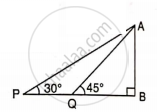Advertisements
Advertisements
Question
Find AB and BC, if:
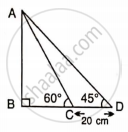
Solution
Let BC = x m
BD = BC + CD = (x + 20) cm
In ΔABD,
tan 45° = `"AB"/"BD"`
1 = `"AB"/(x + 20)`
x + 20 = AB ...(1)
In ΔABC
tan 60° = `"AB"/"BC"`
`sqrt(3) = "AB"/x`
x = `"AB"/sqrt(3)` ...(2)
From (1)
`"AB"/sqrt(3) + 20 = "AB"`
AB + `20sqrt(3) = sqrt(3)"AB"`
AB`(sqrt(3) -1) = 20sqrt(3)`
AB = `(20sqrt(3))/((sqrt(3) - 1)`
AB = `(20sqrt(3))/((sqrt(3) - 1)) xx ((sqrt(3)+1))/((sqrt(3)+1)`
AB = `(20sqrt(3)(sqrt(3) + 1))/(3 - 1)`
AB = 47.32 cm
From (2)
x = `"AB"/sqrt(3)`
x = `(47.32)/sqrt(3)`
x = 27.32 cm
∴ BC = x = 27.32 cm
Therefore, AB = 47.32 cm, BC = 27.32 cm.
APPEARS IN
RELATED QUESTIONS
Find 'x', if :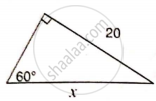
Find angle 'A' if :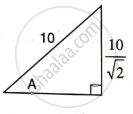
Find the length of AD.
Given: ∠ABC = 60o.
∠DBC = 45o
and BC = 40 cm.
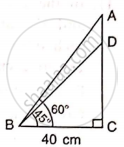
Find the lengths of diagonals AC and BD. Given AB = 60 cm and ∠ BAD = 60°.

In trapezium ABCD, as shown, AB // DC, AD = DC = BC = 20 cm and ∠ A = 60°. Find: length of AB
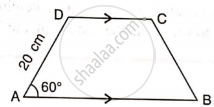
Find: BC
Find: AD

Find: AC

A kite is attached to a 100 m long string. Find the greatest height reached by the kite when its string makes an angles of 60° with the level ground.
Find PQ, if AB = 150 m, ∠P = 30° and ∠Q = 45°.
.